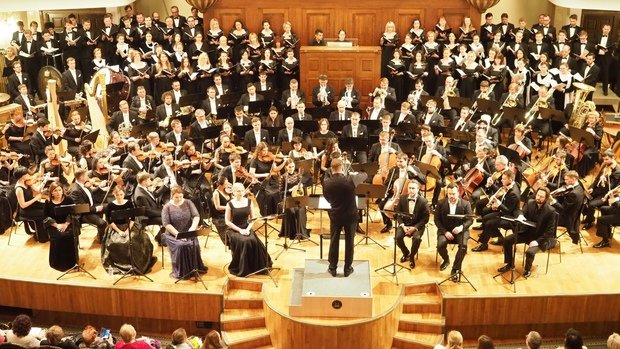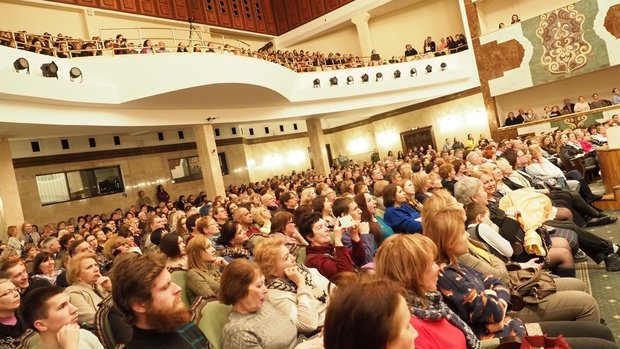Aleksandr Sladkovsky makes ''the universe sound in tone''
The Tatarstan State Symphony Orchestra has played Gustav Mahler’s Symphony No. 8 for the first time
The Tatarstan symphony orchestra continues surprising the audience with both premieres and interpretation of complicated music. Mahler's Symphony No. 8 by the Tatarstan State Symphony Orchestra and Aleksandr Sladkovsky was a complex polyphonic canvas, an anthem to a human and the world he lives in. Realnoe Vremya's correspondent visited the symphony's premiere.
Not thousand, but this doesn't matter
Gustav Mahler's Symphony No. 8 is called ''Symphony of a Thousand'' in a sense that a very big number of musicians are involved when interpreting it. Not a thousand, of course, but does an accurate calculation matter?
The Tatarstan State Symphony Orchestra, three choirs and eight soloists – 200 people – were on the stage in the Tatarstan State Big Concert Hall on 9 February. They all created a symphony canvas consisting of many figures, speaking the terminology characteristic for visual arts. Maestro Sladkovsky led them like a smart strategist and commander. Going ahead, I will say the victory was undoubted.
Mahler's Symphony No. 8 is the monumental composition of the composer that was created surprisingly within 8 weeks in 1906. The symphony consists of two parts, Catholic hymn Come, Creator Spirit was used in the first part, and the second part is very and very unexpected.

The composer used the final scene from Goethe's Faust in the second part. The allusion to Faust, in general, attracts composers. Everyone interprets Goethe in one's own way, and these interpretations extend from a love story of Faust and Margarete to analysis of critical mind. Gounod, Berlioz, Schumann, Wagner wrote music having been inspired by Faust.
For his symphony, Mahler chose right the final scene, and his attraction to romanticism, which is, by the way, is well expressed in Sladkovsky, is seen here. If the conductor didn't understand and feel romanticism, he wouldn't be such an amazing interpreter of Mahler. And not only him, of course.
For European art, the early last century is characteristic for searches for an ideal, attempts to find it the eternal feminine. In pure love that elevates. Philosopher Vladimir Solovyov, for instance, pays tribute to these pursuits in Russia, and his endeavours are echoed in the soul of his young relative – poet Aleksandr Blok. The entire Verses about the Beautiful Lady is a story of such a search.
Mahler also looks for ''the eternal feminine''.
''All earth comprises Is symbol alone;
What there ne'er suffices.
As fact here is known:
All past the humanly
Wrought here in love;
The Eternal-Womanly
Draws us above.''
These lines can be considered an epigraph to Mahler's Symphony No. 8. And to the interpretation of this symphony by Aleksandr Sladkovsky's orchestra.

Sound in tone
Mahler wrote in a letter to his friend: ''It is the greatest thing I have as yet done. And so strange both in content and form, that it is really not possible to write about it. Imagine that the whole universe begins to sound in tone. The result is not merely human voices singing, but a vision of planets and suns coursing about.'' The very figurative and accurate analysis of Symphony No. 8 was obviously accepted by Aleksandr Sladkovsky.
It's a top-class performance for an orchestra to play Symphony No. 8, but maestro Sladkovsky, as one can notice, focuses on precisely complicated music. In addition, he is in his element here – lyrical, life-affirming – when a listener lives in the atmosphere of gratitude for life granted by Most High for almost 1,5 hours, while the symphony is performed.
The interpretation of Mahler's Symphony No. 8 by Sladkovsky is Christian – God is Love. The choir's monumental composition in the first part, this elevated anthem when souls of both the musicians and listeners seem to see the summit is about it. The orchestra's sound contains both tragedy and life affirmation, it contains light and faith.
The second part opened with an entrance as if we slowly approached the main events, vastness, the air – the orchestra's sound had it all. The choir started to sound, the second one joined it like an echo in the mountains. Vasily Ladyuk'v divine baritone and Aleksey Tatarintsev's other-worldly tenor got involved in this sound. The orchestra, the choirs and the soloists praised the eternal femininity.

Orthodox philosopher Aleksandr Yelchaninov once said that a human's soul is consciously drawn to joy, and probably this aspiration has a memory of lost paradise. The way the maestro was conducting on 9 February had an insisting, bright desire to receive this inner joy from the audience, this clarity and gratitude, this lost memory.
The final of Symphony No. 8 is a powerful music wave, it almost flooded the hall like a tsunami. ''Bravo''s after fractions of seconds after the last chord sounded, the pale but happy face of the conductor and long-long ovation.
''Love is what makes the sun and stars move'' – this is what maestro Sladkovsky showed us that evening. The love that should only rule the world, without which there is no faith, no hope. Moscow citizens were going to hear Mahler's Symphony No. 8 on 11 February. The concert was to be in Zaryadye hall.